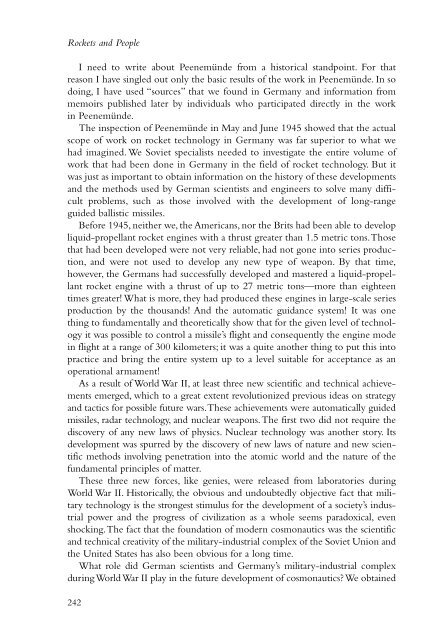to open next chapter. - NASA's History Office
to open next chapter. - NASA's History Office
to open next chapter. - NASA's History Office
Create successful ePaper yourself
Turn your PDF publications into a flip-book with our unique Google optimized e-Paper software.
Rockets and People<br />
I need <strong>to</strong> write about Peenemünde from a his<strong>to</strong>rical standpoint. For that<br />
reason I have singled out only the basic results of the work in Peenemünde. In so<br />
doing, I have used “sources” that we found in Germany and information from<br />
memoirs published later by individuals who participated directly in the work<br />
in Peenemünde.<br />
The inspection of Peenemünde in May and June 1945 showed that the actual<br />
scope of work on rocket technology in Germany was far superior <strong>to</strong> what we<br />
had imagined. We Soviet specialists needed <strong>to</strong> investigate the entire volume of<br />
work that had been done in Germany in the field of rocket technology. But it<br />
was just as important <strong>to</strong> obtain information on the his<strong>to</strong>ry of these developments<br />
and the methods used by German scientists and engineers <strong>to</strong> solve many difficult<br />
problems, such as those involved with the development of long-range<br />
guided ballistic missiles.<br />
Before 1945, neither we, the Americans, nor the Brits had been able <strong>to</strong> develop<br />
liquid-propellant rocket engines with a thrust greater than 1.5 metric <strong>to</strong>ns.Those<br />
that had been developed were not very reliable, had not gone in<strong>to</strong> series production,<br />
and were not used <strong>to</strong> develop any new type of weapon. By that time,<br />
however, the Germans had successfully developed and mastered a liquid-propellant<br />
rocket engine with a thrust of up <strong>to</strong> 27 metric <strong>to</strong>ns—more than eighteen<br />
times greater! What is more, they had produced these engines in large-scale series<br />
production by the thousands! And the au<strong>to</strong>matic guidance system! It was one<br />
thing <strong>to</strong> fundamentally and theoretically show that for the given level of technology<br />
it was possible <strong>to</strong> control a missile’s flight and consequently the engine mode<br />
in flight at a range of 300 kilometers; it was a quite another thing <strong>to</strong> put this in<strong>to</strong><br />
practice and bring the entire system up <strong>to</strong> a level suitable for acceptance as an<br />
operational armament!<br />
As a result of World War II, at least three new scientific and technical achievements<br />
emerged, which <strong>to</strong> a great extent revolutionized previous ideas on strategy<br />
and tactics for possible future wars.These achievements were au<strong>to</strong>matically guided<br />
missiles, radar technology, and nuclear weapons.The first two did not require the<br />
discovery of any new laws of physics. Nuclear technology was another s<strong>to</strong>ry. Its<br />
development was spurred by the discovery of new laws of nature and new scientific<br />
methods involving penetration in<strong>to</strong> the a<strong>to</strong>mic world and the nature of the<br />
fundamental principles of matter.<br />
These three new forces, like genies, were released from labora<strong>to</strong>ries during<br />
World War II. His<strong>to</strong>rically, the obvious and undoubtedly objective fact that military<br />
technology is the strongest stimulus for the development of a society’s industrial<br />
power and the progress of civilization as a whole seems paradoxical, even<br />
shocking.The fact that the foundation of modern cosmonautics was the scientific<br />
and technical creativity of the military-industrial complex of the Soviet Union and<br />
the United States has also been obvious for a long time.<br />
What role did German scientists and Germany’s military-industrial complex<br />
during World War II play in the future development of cosmonautics? We obtained<br />
242
















